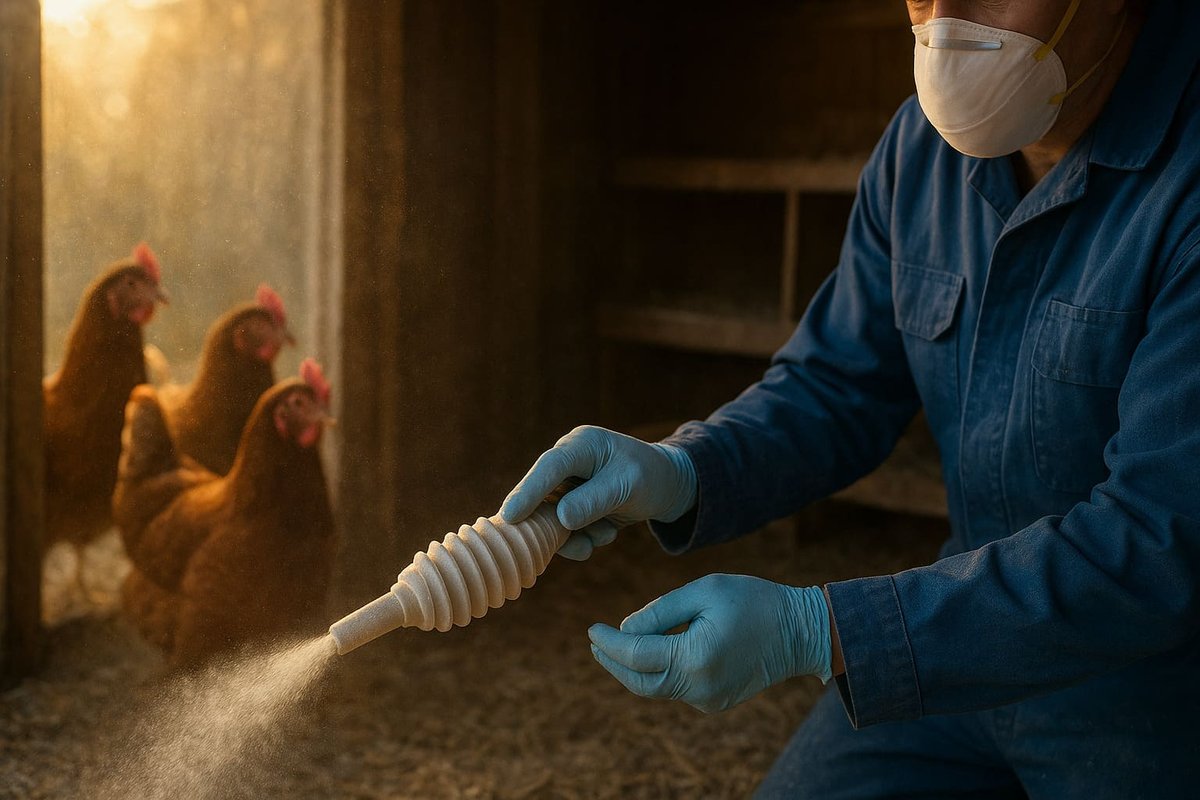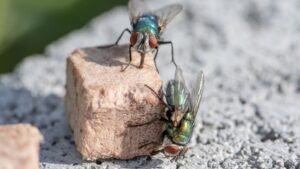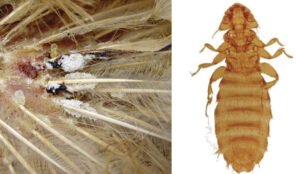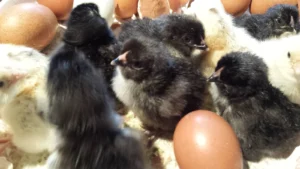I’ll never forget the dread that washed over me when I first saw them—tiny, creepy crawlies skittering in the cracks of my coop. My heart just sank. If you’re staring down a mite infestation, trust me, you’re not alone. It’s an incredibly common problem, and these stubborn parasites are a huge headache for chicken keepers everywhere. Spotting them is a good reminder to do a regular chicken health check to catch things early. Your first thought might be to grab the strongest chemical you can find, but what if there was a natural, effective option? That’s where diatomaceous earth (DE) comes in. It’s a game-changer for my flock management, especially for their dust baths.
This guide is pretty much everything I’ve learned—through trial, error, and a lot of reading—about using this amazing natural powder. So what is diatomaceous earth for chickens mites? It’s just the fossilized remains of tiny aquatic organisms called diatoms. The best part? It works physically, not chemically, so mites can’t build up resistance. We’ll get into what DE is, how it works, the right way to use it, and—most importantly—the safety steps to protect you and your birds. Let’s get your coop back to being a safe, pest-free home for your flock.
Quick Facts: Key Takeaways on Diatomaceous Earth for Chickens Mites
- What it is: A natural, fossilized powder that kills mites by physically tearing up their shells and drying them out.
- Use Food-Grade & OMRI Certified: NEVER use pool-grade DE. Stick to food-grade, and look for the OMRI (Organic Materials Review Institute) seal for extra peace of mind.
- Dryness is Key: DE works best when it’s dry. If the humidity gets above 85%, its effectiveness plummets.
- Safety First: Always wear an N95 dust mask when you’re spreading it around. Your lungs will thank you.
- Not a Magic Bullet: It’s great for prevention and light infestations, but don’t count on it for a full-blown mite apocalypse. You’ll need bigger guns for that.
- Reapplication is Crucial: You have to apply it weekly for 2-3 weeks to actually break the mite life cycle.
Understanding How Diatomaceous Earth Works on Chicken Mites
So how can a simple powder be so deadly? It’s all about the structure. The fine, flour-like powder feels silky, but under a microscope, it’s a field of razor-sharp shards. To a mite, crawling through DE is like walking through broken glass. These microscopic edges shred its waxy outer shell.
This creates a one-two punch:
- Physical Damage: The sharp bits tear through the mite’s protective layer. There’s really no escape.
- Dehydration: Once that shell is broken, DE’s natural desiccant properties get to work, sucking the moisture right out of the mite’s body until it dies.
It’s this physical attack that makes DE so useful against poultry parasites. Unlike chemicals, pests can’t develop an immunity to being shredded and dried out. Lab studies show food-grade DE can achieve 100% mite death in 24 to 48 hours in dry conditions. The biggest catch, though, is moisture. Get it wet, and it’s basically useless. That’s why a dry application in a dry coop is everything.
Laboratory vs. Reality: A Critical Distinction
While DE is a rockstar in the lab, let’s be real—your coop isn’t a sterile environment. Real-world results can be a lot less predictable. Things like humidity, all the dust and gunk from bedding, and the fact that mites are masters of hiding in deep cracks can all get in the way of DE’s effectiveness.
Now that you know the “how,” let’s talk about the little villains you’re up against.
Does Diatomaceous Earth Kill Chicken Mites and Lice?
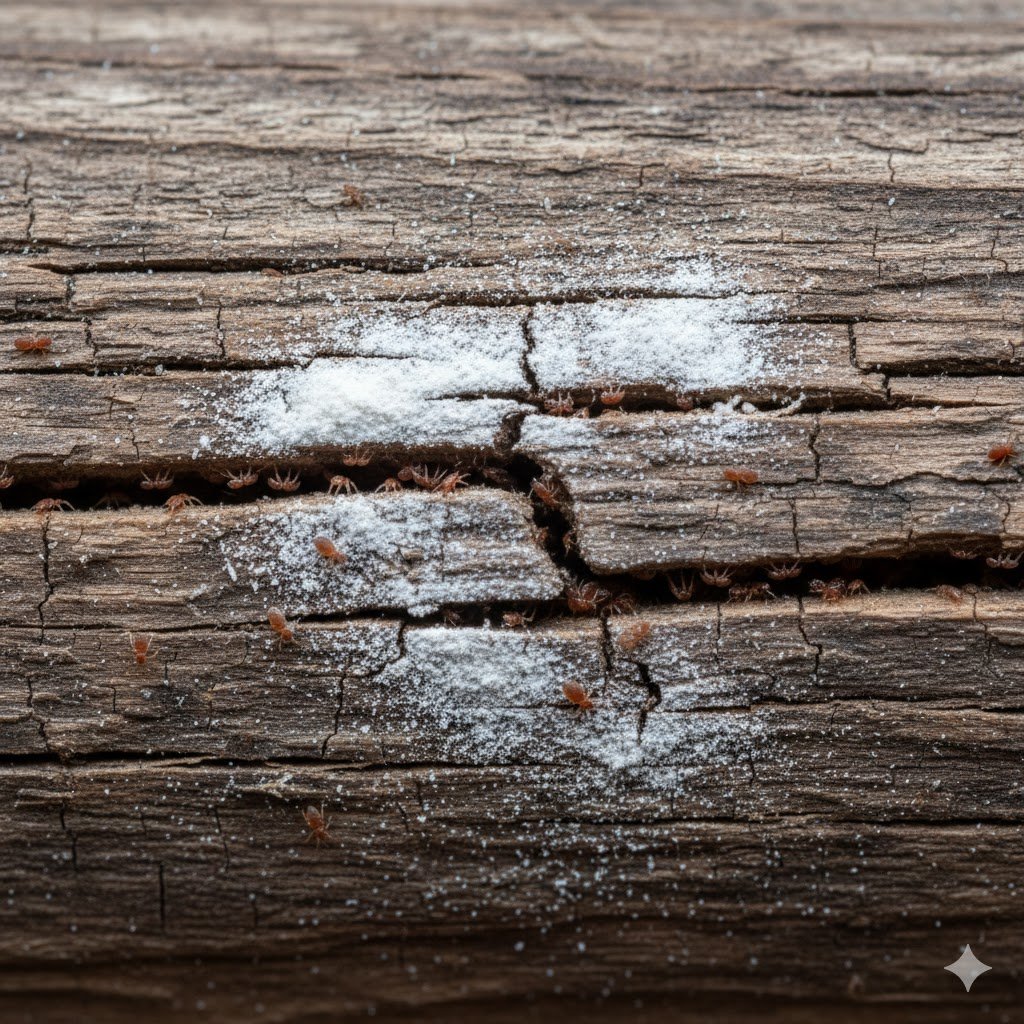
Knowing your enemy is half the battle. To treat your flock right, you first need to learn to identify different types of mites and lice. Getting familiar with the common parasitic mites in poultry systems is a good start. Here are the ones DE works on:
- Red Mites (Dermanyssus gallinae): I call these the vampires of the chicken world. Their fancy name is Dermanyssus gallinae. They hide in cracks during the day and crawl onto sleeping hens at night for a blood meal. A bad infestation can cause anemia, stress, and a nosedive in egg production. DE is great for treating the coop where these pests hide.
- Northern Fowl Mites (Ornithonyssus sylviarum): Unlike red mites, these guys, Ornithonyssus sylviarum, live their entire lives on the chicken, usually around the vent. They cause dirty-looking feathers and scabby skin. Dusting your birds directly can be an effective way to manage them.
- Chicken Lice: Yep, DE works on chicken lice too. They’re bigger than mites and eat skin and feather bits. Research has found that even a few lice can make chickens preen constantly, messing up their eating, sleeping, and laying schedules. A direct dusting with food-grade DE will wreck their exoskeletons just like it does with mites.
A Note on Scaly Leg Mites
Scaly leg mites are a whole different problem. These mites burrow under the scales on a chicken’s legs. Spreading DE in the coop might get any that fall off, but it won’t touch the ones protected under the skin. For these, you have to soak your chicken’s legs in warm water and then slather on a thick coat of petroleum jelly or a natural salve to suffocate them.
How to use diatomaceous earth for chickens mites (Step-by-Step)
Proper application is everything. A casual sprinkle here and there won’t cut it. Here are the three main ways I use it for a full coop treatment.
1. Coop Treatment Protocol
This is your main line of attack, especially for red mites (Dermanyssus gallinae).
- Clean Out Completely: Muck out all the old bedding. I mean all of it. A shop vac is your best friend for getting into every last corner and crevice.
- Dry Thoroughly: Make sure the coop is bone dry. Did I mention moisture is the enemy?
- Apply DE: Use a bellows duster or an old spice shaker to puff a fine, even layer of DE everywhere. It should give the wood a whitish, almost frosty look. Hit the corners, cracks, perch ends, and nesting boxes hard before you add any fresh bedding. The air will get dusty, so keep your mask on!
Pro-Tip for Litter Management: Want to level-up your deep litter method and cut down on the stink? Try this mix. Combine equal parts DE, baking soda, and crushed limestone. Sprinkle a light layer on the coop floor before adding bedding, and then add a little more on top each week. This combo is amazing at absorbing moisture and keeps the coop smelling much fresher for longer.
2. Direct Application on Chickens
For pests living on your birds, you have to take the fight to them.
- Grab Your Bird: It’s way easier to do this at night when they’re calm and groggy. Seriously, grab a friend if you can—it makes a world of difference.
- Protect the Head: Gently cover the chicken’s head with a cloth. The last thing you want is for them to breathe in this fine powder.
- Dust the Bird: Part the feathers and puff a little DE right onto the skin. Focus on the vent area and under the wings. A little goes a long way.
Pro-Tip: To make this less of an ordeal, get your chickens used to being handled. A few mealworms afterward can help them decide you’re not so bad after all.
3. Dust Bath Integration
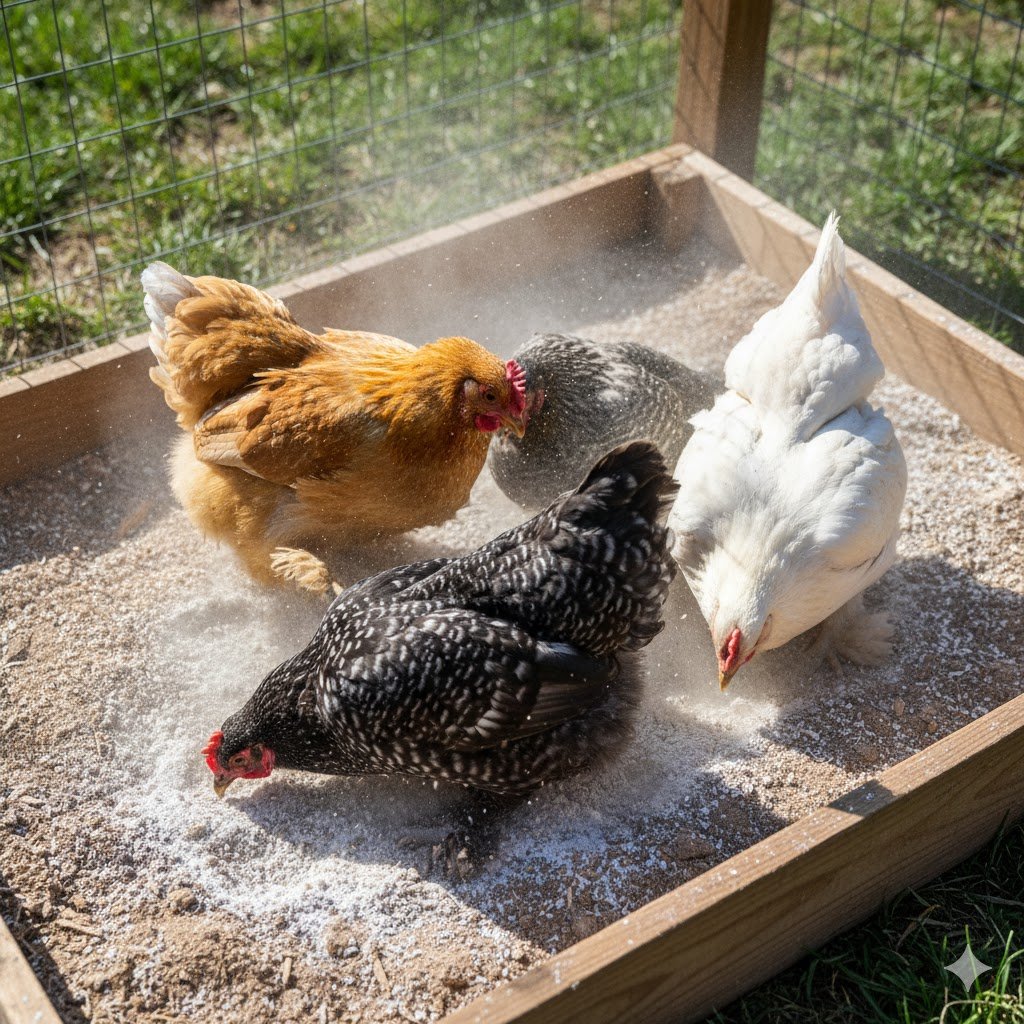
Why not get your chickens to do the work for you? Supercharge their natural cleaning routine by setting up a proper dust bath.
- Mix It In: As one of my favorite dust bath additives, I add about 1 cup of DE for every gallon of dust bath material (dirt, sand, etc.). For an extra punch, I also mix in some wood ash and a scoop of montmorillonite or bentonite clay. These clays help absorb toxins and keep feathers in great shape.
- Encourage Use: Put the dust bath in a sunny, protected spot where your chickens like to hang out. If they’re ignoring it, a sprinkle of scratch grains usually piques their interest.
- Maintain: Keep it dry! If it gets wet, scoop out the damp stuff and replace it.
How Often Should I Sprinkle DE in the Chicken Coop?
Consistency is what wins the war against the mite life cycle. How often you apply depends on whether you’re fighting an invasion or just trying to keep the peace.
Quick Guide: How Often to Apply DE
| Situation | Method | Frequency |
|---|---|---|
| Active Infestation | Coop Treatment | Weekly for 2-3 weeks |
| Direct on Bird | Repeat after 7-10 days | |
| Ongoing Prevention | Coop Treatment | Monthly |
| Dust Bath | Keep topped up continuously |
Diatomaceous earth for chickens mites dosage
For Coop Application:
- Light Dusting/Prevention: About 1 cup per 100 square feet is plenty for a light, visible film. You’re not trying to make snow drifts, just a fine coat.
- Heavy Infestation: Bump it up to 2-3 cups per 100 square feet, and really work it into any cracks.
- Perch Treatment: Don’t just sprinkle the perches. Grab a handful and rub it hard into the wood, especially the undersides and ends where mites love to hide.
How to Mix Diatomaceous Earth with Chicken Feed for Better Egg Quality
Adding DE to feed… talk about a debated topic in the chicken world. Some people swear by it, others think it’s useless. It shouldn’t be your only defense, but it might be worth a shot alongside proven treatments for internal parasites if you have concerns. Some of the research is pretty compelling.
The Evidence: Breed-Specific Benefits
The conversation always seems to circle back to a 2011 study by Bennett et al.. It showed that DE’s effects can be totally different depending on the chicken breed.
- Bovan Brown hens (which are less parasite-resistant) saw real benefits. They had lower counts of certain worms and even the parasite that causes coccidiosis.
- Lohmann Brown hens (a more resistant breed) saw no real change at all.
What does this tell us? It basically means you need to manage your expectations. DE isn’t a miracle wormer for every chicken, but it might help the gut health of certain breeds. The study also found that the DE-treated Bovan Brown hens had other good results:
- Better Eggs: They laid bigger eggs with more yolk and albumen.
- More Efficient Eaters: They got more nutrition from the same amount of feed—a great sign of health that can also save you money.
- Gut Health (The 2025 Revolution): What’s really interesting is the new science coming out. Research from 2025 found that mixing DE with bentonite clay did some wild things to the chicken gut microbiome. A remarkable 13 unique beneficial bacterial species showed up only in the treated birds. This suggests the combo can actively create a healthier gut, which is a big deal for a chicken’s immunity. It’s a similar idea to the benefits of fermenting chicken feed.
Step-by-Step Mixing Technique
If you’re going to try it, you have to mix it evenly. You don’t want just one chicken getting all the DE. It’s an easy step if you already make your own chicken feed.
- Measure It Out: The usual advice is to make DE 2% of the feed’s total weight. An easy way to do this is about 1 cup of DE for a 20kg (~44lb) bag of feed. Some people also go by 6 cups per 50 pounds of feed.
- Use a Binder: This is the most important step. If you just dump dry DE powder into dry feed, it will all settle at the bottom. You need something to make it stick.
- My Go-To: Cod Liver Oil. I like using a tiny bit of cod liver oil. It makes the DE stick and gives the chickens extra Omega-3s and Vitamins A & D. You only need a light drizzle.
- Other Options: A light mist of water, olive oil, or another healthy oil works too.
- Mix, Mix, Mix: In a big bucket, add your feed, drizzle the oil, and toss it well. Then, sprinkle in the DE and keep mixing until you can’t see any white clumps.
Safety, Side Effects, and Precautions
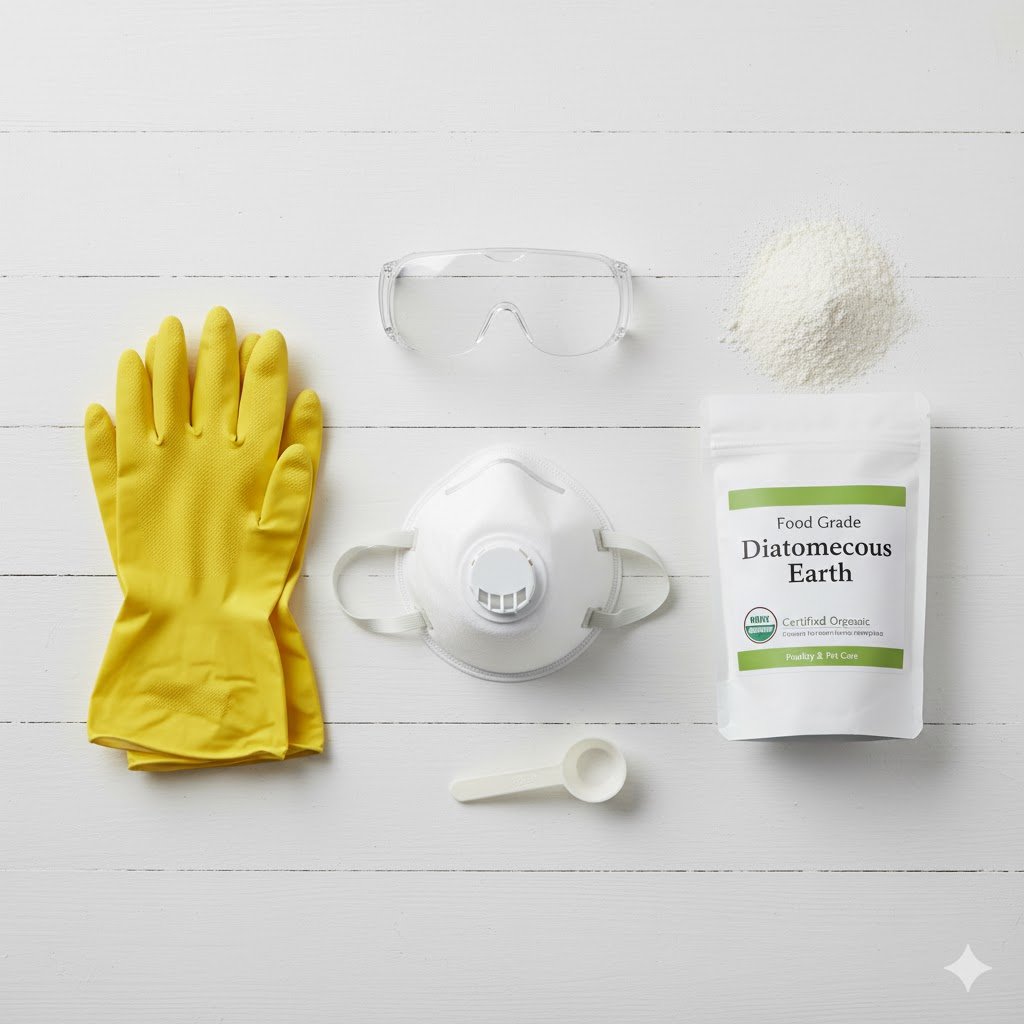
Okay, this is the part I really need you to pay attention to: safety first. While DE is natural, you’re still dealing with a very fine dust when using diatomaceous earth for chickens mites.
Crystalline vs Amorphous Silica: The Critical Difference
The key to safety is knowing the two types of silica in DE.
- Amorphous Silica: This is what’s in food-grade DE. It’s non-crystalline and considered safe to eat. An OMRI certification is a good sign you’re getting a pure product.
- Crystalline Silica: This is created when DE is super-heated to make pool-grade DE. It’s a known carcinogen and is extremely dangerous to breathe.
WARNING: DANGER OF POOL-GRADE DE You must NEVER use pool-grade or filter-grade DE for your animals or garden. The crystalline silica in it is super toxic when inhaled and can cause serious, permanent lung damage to you and your flock. Always, always check the label for “Food-Grade.”
Is diatomaceous earth safe for chickens to eat
Yes, food-grade DE (made of amorphous silica) is safe for chickens to eat. The FDA calls it “Generally Recognized as Safe” (GRAS). It just passes through their digestive system without being absorbed. Just remember, DE is not a replacement for grit, which they need to grind up their food. You can read more on whether chickens need grit or oyster shells here.
Diatomaceous Earth for Chickens Mites: Side Effects
The main problems with DE come from breathing it in, not eating it.
- Respiratory Irritation: This is the biggest risk for you and your flock. Breathing in the fine powder can irritate lungs. Always wear an N95-rated dust mask. Apply it on a calm day, and let the dust settle completely before letting the chickens back in.
- Skin and Eye Irritation: DE is very drying. It can irritate your skin and eyes. I’d recommend gloves and safety glasses if you’re doing a big clean-out.
Other Composition and Feeder Considerations
Food-grade DE also has up to 15 beneficial trace minerals. The exact mix varies, but they often include:
- Calcium
- Potassium
- Copper
- Zinc
- Phosphorous
- Silica
- Selenium
There’s also a debate about using DE in metal feeders. There’s no science saying it’s bad, but some people worry about a long-term reaction and stick to plastic or wood feeders just in case. Your call.
Safe Disposal of Used Bedding
When you clean out a coop you’ve treated with DE, the old bedding can go right into the compost pile. The silica is a natural part of soil. When you use the compost in your garden later, the DE can even help improve soil structure and aeration. Just wear a mask when you’re turning the compost pile.
Will Diatomaceous Earth Get Rid of Chicken Mites?
This is the million-dollar question, right? Will diatomaceous earth for chickens mites actually solve your problem? The short answer is yes… but it comes with some big “ifs.” It works very well in the right conditions—a dry environment where it can make direct contact with the pests. For a mild to moderate problem, a consistent and thorough DE routine is often enough to wipe it out.
But you have to be realistic. In the real world, many studies have called DE’s effectiveness “equivocal”—meaning the results are all over the place. In a humid coop with lots of dusty bedding, it’s just not as reliable.
Think of it as a fantastic tool in your toolbox, but not a magic wand. For a really bad infestation, it might not work fast enough to save a bird that’s already weak.
Effectiveness Timeline and Expectations
Don’t expect overnight miracles. I was so impatient my first time, but you have to play the long game.
- Initial Kill: Mites should start dying within 12-48 hours of contact.
- Visible Reduction: You should see fewer mites within 3-5 days. Your chickens might seem less agitated.
- Complete Elimination: Wiping out the whole infestation usually takes 2-3 weeks of reapplying. You have to kill the new hatchlings. Don’t stop after one treatment!
- Prevention: A monthly application is now part of my regular routine to stop them from coming back.
Seasonal Considerations: Summer vs. Winter Application
Mites have their favorite seasons, so your DE strategy should change with the weather.
- Summer: Peak mite season. Warm, humid weather is a breeding ground for them. High humidity is a challenge for DE, so good coop ventilation is critical. You’ll probably need to apply DE more often. This is the perfect time for those top-notch, DE-treated dust baths.
- Winter: Mites slow down in the cold, but they don’t vanish. They hide deep in the coop or on the birds. The good news? Coops are usually drier in winter, which makes DE very effective. A big clean-out and DE treatment at the start of winter can really knock back the population and give you a head start for spring. A good winterizing routine can also help you spot other issues, like how to prevent frostbite on combs.
Troubleshooting Common Problems
Even with a solid plan, things can go wrong. Here are a few issues I’ve run into.
- Problem: My chickens are avoiding the dust bath.
- Solution: You probably used too much DE. Chickens don’t want to roll in a giant cloud of powder. Try scooping some out and mixing in more plain dirt or sand. A few scratch grains sprinkled on top can also lure them back.
- Problem: I live in a humid climate and DE won’t stay dry.
- Solution: This is a tough one because moisture is DE’s kryptonite. Focus on the driest parts of the coop and think about improving ventilation with a fan. You’ll have to reapply it more often, especially after damp weather. In really humid places, DE might be more of a supporting player than the star of your pest control plan.
- Problem: I’m not seeing results and the mites are still everywhere.
- Solution: If you’ve been at it for 2-3 weeks and the mites are still throwing a party, or if your chickens seem pale, lethargic, or stressed, it’s a sign that DE just isn’t cutting it for your situation. It’s time to switch to something stronger and faster. Don’t wait and let your flock suffer—a bad infestation needs a quick, decisive response.
When NOT to Use Diatomaceous Earth
As much as I like DE, it’s not the answer for everything. There are times to use something else:
- Severe Infestations: If your chickens are weak or anemic, they need help now. DE is too slow. A heavy infestation can kill a chicken, so you need to act fast.
- Wet or Humid Conditions: If your coop is constantly damp, DE’s power will be severely limited.
- Chickens with Respiratory Issues: If a bird is already coughing or sneezing, don’t throw a bunch of fine dust around them. It could make things worse.
- As Your Only Dewormer: The science is mixed at best. Think of DE as a gut health supplement, not a replacement for a vet-recommended dewormer if you know you have a worm problem.
Alternative Treatments and Combination Strategies
When diatomaceous earth for chickens mites just isn’t cutting it, you need a Plan B. It’s time to look at other natural parasite prevention methods. For really tough cases, having other tools is essential. University extension services, like this one from Virginia Tech, have great, practical advice. Some folks also swear by other supplements like apple cider vinegar for their chickens.
Understanding the Role of Different Treatments
- For Severe Infestations (The Knockdown): When the mites are winning and your birds are suffering, you need something that works immediately. This is where treatments like Spinosad (Elector PSP) or vet-prescribed Ivermectin come in. The goal is to slash the mite population and save your birds.
- For Coop Sanitation (The Clean-Up): Products like Poultry Shield aren’t pesticides for your birds; they are heavy-duty coop cleaners. They dissolve the mites’ waxy shells and break down the gunk where they lay their eggs. This is a key step after a big clean-out.
- For Prevention & Maintenance (The Long Game): This is where DE really shines. Once the crisis is over, using DE in the coop and dust baths creates a long-term barrier that kills off stragglers and prevents a new infestation. Another option here is the fungus Beauveria bassiana, a biological control that has shown some promising results.
A Practical Combination Strategy
Here’s how you could combine these to fight off a really tough infestation:
- Day 1 (Immediate Action): If birds are covered, treat them with a fast-acting product like Elector PSP. Follow the directions to the letter.
- Day 2 (Coop Blitz): Get the birds out. Do a complete muck-out. Scrape everything. Then spray the entire interior with a cleaner like Poultry Shield. Let it dry completely.
- Day 3 (DE Application): Once the coop is bone dry, dust it thoroughly with food-grade DE. Hit all the hiding spots. Then add fresh bedding and let the flock return.
- Ongoing: Keep the DE-treated dust baths fresh and re-dust the coop weekly for three weeks to kill any new hatchlings. After that, you can switch to a monthly schedule.
Using everything together—the right tool for the right job—is way more effective than just relying on one thing.
Cost-Benefit Analysis: DE vs. Chemicals
It’s worth thinking about the cost. A bottle of something like Elector PSP can be expensive upfront, but if it wipes out a severe infestation in one go, it might save you more in the long run by preventing lost egg production or even saving a chicken’s life. DE is cheap for a big bag that will last forever. But the hidden “cost” is your time and labor, and the risk that it might not be strong enough, letting the problem get worse. For prevention, DE is the clear cost winner. For a crisis, a chemical treatment is often a better investment.
Here’s a quick comparison:
| Treatment | Effectiveness | Cost | Egg Withdrawal Period | Safety Profile |
|---|---|---|---|---|
| Diatomaceous Earth | Slower-acting; mechanical killer. Best for prevention & mild cases. Useless when wet. | Low | None | Food-grade is safe to eat. Main risk is breathing the dust. |
| Spinosad (Elector PSP) | Very high; fast-acting. A top choice for severe infestations. | High | None | Considered safe when used as directed. |
| Ivermectin | High; systemic. Often used off-label, so you need a vet’s guidance. | Medium | Varies (e.g., 7+ days) | Risk of overdose. Must follow a strict egg withdrawal. |
| Poultry Shield | Cleaner for coops, not a direct pesticide. Breaks down mite habitat. | Low-Medium | None | Safe for cleaning, but coop must be dry before birds return. |
Where to Buy and Product Selection
You can find food-grade DE at most farm supply stores, garden centers, and online.
- Look for “Food-Grade”: It has to say this on the package. No exceptions.
- Check for OMRI Certification: A product listed with the Organic Materials Review Institute (OMRI) is certified for organic use. It’s an extra layer of confidence.
- Consider Blends: You might see products mixed with montmorillonite clay (bentonite clay). This is usually added for gut health and to help absorb toxins.
- Reputable Brands: Go with a trusted brand.
- Cost: Expect to pay around $15-$30 for a 10-20 pound bag. For a small flock, that will last a long time.
Frequently Asked Questions (FAQ)
Will diatomaceous earth get rid of chicken mites? Yes, diatomaceous earth for chickens mites can work, especially for mild to moderate problems. But it’s not a sure thing. If it’s too humid or the infestation is really bad, it might not be enough on its own. It’s one tool, not the whole toolbox.
Why not use diatomaceous earth for chickens? The biggest reasons for caution are safety and its limits. The dust can irritate your lungs and your flock’s, so a mask is a must. Don’t use it around birds that already have respiratory issues. It’s also useless when wet and might not be strong enough for a major mite invasion.
Does diatomaceous earth kill worms in chickens? The scientific evidence just isn’t there to call it an effective dewormer. The results seem to vary by chicken breed and parasite. It’s better to think of it as a gut health supplement, not a primary treatment for worms.
Can I use DE in a humid climate? You can try, but you’ll have to adjust your expectations. DE really loses its punch when humidity is over 85%. Focus on the driest areas of the coop, get a fan for ventilation, and reapply it much more often.
Can I sprinkle diatomaceous earth in my chicken run? Sure, but it won’t do much good outdoors where it’s exposed to moisture. I stick to dry, covered spots, like under the coop, and always reapply after it rains.
What happens if diatomaceous earth gets wet? It stops working. But, once it dries out completely, it’s effective again. This is why keeping the coop and dust baths dry is so critical.
Is diatomaceous earth safe for young chicks? Be extra careful with chicks. Their respiratory systems are super delicate. I’d avoid using it in the brooder until they’re a few weeks old. If you absolutely have to, apply a very thin layer under the bedding while they’re out, and let all the dust settle before they come back in.
Does DE kill beneficial insects? Yes, unfortunately. DE is an equal-opportunity killer for any insect with an exoskeleton. It will harm good bugs too. That’s why I only use it inside the coop and don’t broadcast it all over the yard.
Conclusion – A Key Tool in Your Flock Management Toolbox
Dealing with a mite infestation can feel like a losing battle, but you’ve got a powerful, natural tool in your corner. Using diatomaceous earth for chickens mites is a solid, affordable way to protect your flock. Once you get the hang of how it works, how to apply it, and the safety rules, you’ll be able to manage parasites with confidence.
Just remember the big rules: food-grade only, always wear a mask, and keep reapplying to break that pest life cycle. It’s a key part of my playbook for keeping my chickens healthy, and now it can be part of yours, too.

Oladepo Babatunde is the founder of ChickenStarter.com. He is a backyard chicken keeper and educator who specializes in helping beginners raise healthy flocks, particularly in warm climates. His expertise comes from years of hands-on experience building coops, treating common chicken ailments, and solving flock management issues. His own happy hens are a testament to his methods, laying 25-30 eggs weekly.
